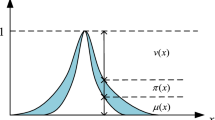Abstract
Linear regression analysis in an intuitionistic fuzzy environment using intuitionistic fuzzy linear models with symmetric triangular intuitionistic fuzzy number (STriIFN) coefficients is introduced. The goal of this regression is to find the coefficients of a proposed model for all given input–output data sets. The coefficients of an intuitionistic fuzzy regression (IFR) model are found by solving a linear programming problem (LPP). The objective function of the LPP is to minimize the total fuzziness of the IFR model which is related to the width of IF coefficients. An illustrative example is also presented to depict the solution procedure of the IFR problem by using STriIFNs.
Similar content being viewed by others
References
Akram M. (2011) Bipolar fuzzy graphs. Information Sciences 181: 5548–5564
Akram M. (2012) Interval-valued fuzzy line graphs. Neural Computing and Applications 21: 145–150
Akram M., Dudek W. A. (2008) Intuitionistic fuzzy left k-ideals of semirings. Soft Computing 12: 881–890
Akram M., Dudek W. A. (2012) Regular bipolar fuzzy graphs. Neural Computing and Applications 21: 197–205
Angelov, P. (1997). Optimization in an intuitionistic fuzzy environment. Fuzzy Sets and Systems, 68, 301–306.
Atanassov K. T. (1986) Intuitionistic fuzzy sets. Fuzzy Sets and Systems 20: 87–96
Diamond P. (1988) Fuzzy least squares. Information Sciences 46: 141–157
Ishibuchi H. (1992) Fuzzy regression analysis. Japan Journal of Fuzzy Theory and Systems 4: 137–148
Kacprzyk J., Fedrizzi M. (1992) Fuzzy regression analysis. Physica-Verlag, Heidelberg
Kleinbaum D. G., Kupper L. L. (1978) Applied regression analysis and other multivariable methods. Wadsworth, Belmont, CA
Mahapatra, B. S., & Mahapatra, G. S. (2010). Intuitionistic fuzzy fault tree analysis using intuitionistic fuzzy numbers. International Mathematical Forum, 5(21), 1015–1024.
Mahapatra G. S., Roy T. K. (2009) Reliability evaluation using triangular intuitionistic fuzzy numbers arithmetic operations. International Journal of Mathematical and Statistical Sciences 1(1): 31–38
Nehi H. M. (2010) A new ranking method for intuitionistic fuzzy numbers. International Journal of Fuzzy Systems 12(1): 80–86
Neter J., Wasserman W., Kutner M. H. (1985) Applied linear statistical models. Irwin, Homewood, IL
Park, V., & Corson, S. (2001). Temporally-ordered routing algorithm (TORA), version 1, San Diego, CA: Flarion Technologies, Inc.
Savic D., Pedrycz W. (1991) Evaluation of fuzzy regression models. Fuzzy Sets and Systems 39: 51–63
Tanaka H., Ishibuchi H. (1991) Identification of possibilistic linear systems by quadratic membership functions of fuzzy parameters. Fuzzy Sets and Systems 41: 145–160
Tanaka H., Uejima S., Asai K. (1982) Linear regression analysis with fuzzy model. IEEE Transactions on Systems, Man and Cybernetics 12(6): 903–907
Yager R. R. (2009) Some aspects of intuitionistic fuzzy sets. Fuzzy Optimization and Decision Making 8: 67–90
Yen K. K., Ghoshray S., Roig G. (1999) A linear regression model using triangular fuzzy number coefficients. Fuzzy Sets and Systems 106: 167–177
Zadeh L. A. (1978) Fuzzy sets as a basis for a theory of possibility. Fuzzy Sets and Systems 1: 3–28
Zadeh L. A. (1965) Fuzzy sets. Information and Control 8: 338–353
Author information
Authors and Affiliations
Corresponding author
Rights and permissions
About this article
Cite this article
Parvathi, R., Malathi, C., Akram, M. et al. Intuitionistic fuzzy linear regression analysis. Fuzzy Optim Decis Making 12, 215–229 (2013). https://doi.org/10.1007/s10700-012-9150-9
Published:
Issue Date:
DOI: https://doi.org/10.1007/s10700-012-9150-9




